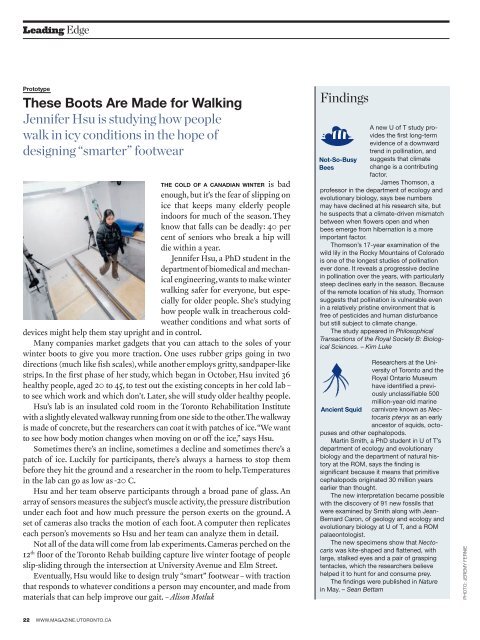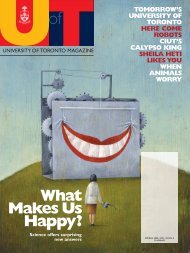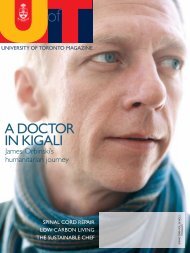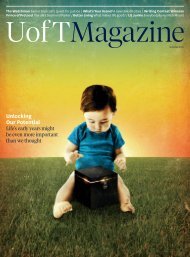The Next Big Idea 10 concepts that could - University of Toronto ...
The Next Big Idea 10 concepts that could - University of Toronto ...
The Next Big Idea 10 concepts that could - University of Toronto ...
Create successful ePaper yourself
Turn your PDF publications into a flip-book with our unique Google optimized e-Paper software.
Leading Edge<br />
Prototype<br />
<strong>The</strong>se Boots Are Made for Walking<br />
Jennifer Hsu is studying how people<br />
walk in icy conditions in the hope <strong>of</strong><br />
designing “smarter” footwear<br />
<strong>The</strong> cold <strong>of</strong> a Canadian winter is bad<br />
enough, but it’s the fear <strong>of</strong> slipping on<br />
ice <strong>that</strong> keeps many elderly people<br />
indoors for much <strong>of</strong> the season. <strong>The</strong>y<br />
know <strong>that</strong> falls can be deadly: 40 per<br />
cent <strong>of</strong> seniors who break a hip will<br />
die within a year.<br />
Jennifer Hsu, a PhD student in the<br />
department <strong>of</strong> biomedical and mechanical<br />
engineering, wants to make winter<br />
walking safer for everyone, but especially<br />
for older people. She’s studying<br />
how people walk in treacherous coldweather<br />
conditions and what sorts <strong>of</strong><br />
devices might help them stay upright and in control.<br />
Many companies market gadgets <strong>that</strong> you can attach to the soles <strong>of</strong> your<br />
winter boots to give you more traction. One uses rubber grips going in two<br />
directions (much like fish scales), while another employs gritty, sandpaper-like<br />
strips. In the first phase <strong>of</strong> her study, which began in October, Hsu invited 36<br />
healthy people, aged 20 to 45, to test out the existing <strong>concepts</strong> in her cold lab –<br />
to see which work and which don’t. Later, she will study older healthy people.<br />
Hsu’s lab is an insulated cold room in the <strong>Toronto</strong> Rehabilitation Institute<br />
with a slightly elevated walkway running from one side to the other. <strong>The</strong> walkway<br />
is made <strong>of</strong> concrete, but the researchers can coat it with patches <strong>of</strong> ice. “We want<br />
to see how body motion changes when moving on or <strong>of</strong>f the ice,” says Hsu.<br />
Sometimes there’s an incline, sometimes a decline and sometimes there’s a<br />
patch <strong>of</strong> ice. Luckily for participants, there’s always a harness to stop them<br />
before they hit the ground and a researcher in the room to help. Temperatures<br />
in the lab can go as low as -20 C.<br />
Hsu and her team observe participants through a broad pane <strong>of</strong> glass. An<br />
array <strong>of</strong> sensors measures the subject’s muscle activity, the pressure distribution<br />
under each foot and how much pressure the person exerts on the ground. A<br />
set <strong>of</strong> cameras also tracks the motion <strong>of</strong> each foot. A computer then replicates<br />
each person’s movements so Hsu and her team can analyze them in detail.<br />
Not all <strong>of</strong> the data will come from lab experiments. Cameras perched on the<br />
12 th floor <strong>of</strong> the <strong>Toronto</strong> Rehab building capture live winter footage <strong>of</strong> people<br />
slip-sliding through the intersection at <strong>University</strong> Avenue and Elm Street.<br />
Eventually, Hsu would like to design truly “smart” footwear – with traction<br />
<strong>that</strong> responds to whatever conditions a person may encounter, and made from<br />
materials <strong>that</strong> can help improve our gait. – Alison Motluk<br />
Findings<br />
Not-So-Busy<br />
Bees<br />
A new U <strong>of</strong> T study provides<br />
the first long-term<br />
evidence <strong>of</strong> a downward<br />
trend in pollination, and<br />
suggests <strong>that</strong> climate<br />
change is a contributing<br />
factor.<br />
James Thomson, a<br />
pr<strong>of</strong>essor in the department <strong>of</strong> ecology and<br />
evolutionary biology, says bee numbers<br />
may have declined at his research site, but<br />
he suspects <strong>that</strong> a climate-driven mismatch<br />
between when flowers open and when<br />
bees emerge from hibernation is a more<br />
important factor.<br />
Thomson’s 17-year examination <strong>of</strong> the<br />
wild lily in the Rocky Mountains <strong>of</strong> Colorado<br />
is one <strong>of</strong> the longest studies <strong>of</strong> pollination<br />
ever done. It reveals a progressive decline<br />
in pollination over the years, with particularly<br />
steep declines early in the season. Because<br />
<strong>of</strong> the remote location <strong>of</strong> his study, Thomson<br />
suggests <strong>that</strong> pollination is vulnerable even<br />
in a relatively pristine environment <strong>that</strong> is<br />
free <strong>of</strong> pesticides and human disturbance<br />
but still subject to climate change.<br />
<strong>The</strong> study appeared in Philosophical<br />
Transactions <strong>of</strong> the Royal Society B: Biological<br />
Sciences. – Kim Luke<br />
Researchers at the <strong>University</strong><br />
<strong>of</strong> <strong>Toronto</strong> and the<br />
Royal Ontario Museum<br />
have identified a previously<br />
unclassifiable 500<br />
million-year-old marine<br />
Ancient Squid carnivore known as Nectocaris<br />
pteryx as an early<br />
ancestor <strong>of</strong> squids, octopuses<br />
and other cephalopods.<br />
Martin Smith, a PhD student in U <strong>of</strong> T’s<br />
department <strong>of</strong> ecology and evolutionary<br />
biology and the department <strong>of</strong> natural history<br />
at the ROM, says the finding is<br />
significant because it means <strong>that</strong> primitive<br />
cephalopods originated 30 million years<br />
earlier than thought.<br />
<strong>The</strong> new interpretation became possible<br />
with the discovery <strong>of</strong> 91 new fossils <strong>that</strong><br />
were examined by Smith along with Jean-<br />
Bernard Caron, <strong>of</strong> geology and ecology and<br />
evolutionary biology at U <strong>of</strong> T, and a ROM<br />
palaeontologist.<br />
<strong>The</strong> new specimens show <strong>that</strong> Nectocaris<br />
was kite-shaped and flattened, with<br />
large, stalked eyes and a pair <strong>of</strong> grasping<br />
tentacles, which the researchers believe<br />
helped it to hunt for and consume prey.<br />
<strong>The</strong> findings were published in Nature<br />
in May. – Sean Bettam<br />
photo: Jeremy Fernie<br />
22 WWW.MAGAZINE.UTORONTO.CA
















